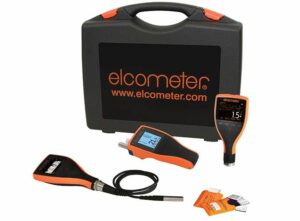Home » Products » Coating Inspection » Surface Preparation » Surface Profiles – Blasted
Surface Profiles - Blasted
Surface Profiles – Blasted
The degree of profile on the surface affects a coating’s overall performance and determines aspects such as adhesion, coverage and overall volume of coatings used. If the profile is too large the amount of coating required increases, otherwise there is a danger that the peaks remain uncoated – allowing rust spots to occur. If the profile is too small there may be an insufficient key for adequate adhesion.
Surface Profiles – achieved through blasting also known as Blast profiles
The proper and effective preparation of a surface prior to coating is essential. Making sure that the correct roughness, or profile, has been generated is essential.
If the profile is too low, the adhesion of the coating to the surface will be reduced. Too high and there is the danger that the profile peaks will remain uncoated – allowing rust spots to occur. If the profile is too high the chances of the paint in the valleys curing correctly are also reduced.
Surface Profiles can be measured in 3 different ways:
Needle type gauges – where the foot of the gauge sits on the peak and the needle extends to the valley or wherever the point is placed. You would take a number of readings to get a correct average, usually 10 readings are required. Needle type gauges can be split into the Analogue Model (Elcometer 123) and the Digital Model (Elcometer 224).
Replica tape – an option where you would rub the tape against the surface and get an image of the surface which you would then measure with the Elcometer 124 Thickness Gauge
Surface Comparator – measuring profile but it is very subjective and not repeatable and reproducible.
AS / NZS Standards
Elcometer P120 Rebar Plus Concrete Rebar Locator – Discontinued
Elcometer NDT CG60DL Corrosion Ultrasonic Thickness Gauge – Discontinued
TH210 Shore D Digital Portable Hardness Tester – Discontinued
Elcometer P100 Imp Concrete Rebar Locator – Discontinued
Elcometer NDT CG60 Corrosion Ultrasonic Thickness Gauge – Discontinued
Elcometer NDT CG50DL Corrosion Ultrasonic Thickness Gauge – Discontinued
Affri Shore D (3002) Portable Hardness Tester / Durometer – Discontinued
Elcometer 5135 5155 Taber Rotary Abrasion Testers – Discontinued
Elcometer NDT CG20 Corrosion Ultrasonic Thickness Gauge – Discontinued


